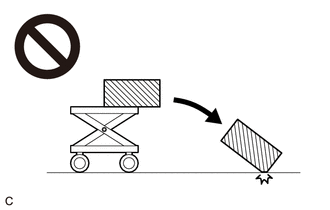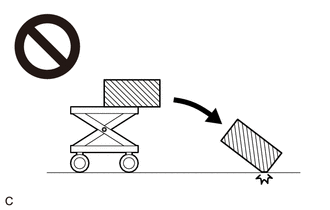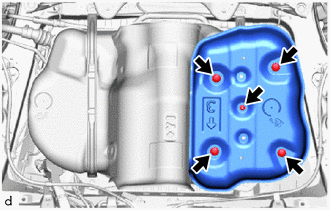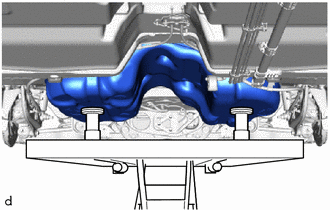Toyota Yaris: Fuel Tank / Removal
REMOVAL
CAUTION / NOTICE / HINT
The necessary procedures (adjustment, calibration, initialization or registration) that must be performed after parts are removed and installed, or replaced during fuel tank assembly removal/installation are shown below.
Necessary Procedures After Parts Removed/Installed/Replaced| Replaced Part or Performed Procedure | Necessary Procedure | Effect/Inoperative Function when Necessary Procedure not Performed | Link |
|---|---|---|---|
| Gas leaks from exhaust system is repaired | Inspection after repair |
|
|
CAUTION:
-
Never perform work on fuel system components near any possible ignition sources.

- Vaporized fuel could ignite, resulting in a serious accident.
-
Do not perform work on fuel system components without first disconnecting the cable from the negative (-) auxiliary battery terminal.

- Sparks could cause vaporized fuel to ignite, resulting in a serious accident.
-
The fuel tank assembly is very heavy. Be sure to follow the procedure described in the repair manual, or the fuel tank assembly may fall off the engine lifter.

NOTICE:
After the ignition switch is turned off, the radio and display receiver assembly records various types of memory and settings. As a result, after turning the ignition switch off, make sure to wait at least 120 seconds before disconnecting the cable from the negative (-) auxiliary battery terminal.
HINT:
When the cable is disconnected/reconnected to the auxiliary battery terminal, systems temporarily stop operating. However, each system has a function that completes learning the first time the system is used.
-
Learning completes when vehicle is driven
Effect/Inoperative Function When Necessary Procedures are not Performed
Necessary Procedures
Link
Lane tracing assist system
Drive the vehicle straight ahead at 35 km/h (22 mph) or more for 5 second or more.

Pre-collision system
Stop and start system
Drive the vehicle until stop and start control is permitted (approximately 5 to 60 minutes)

-
Learning completes when vehicle is operated normally
Effect/Inoperative Function When Necessary Procedures are not Performed
Necessary Procedures
Link
Power door lock control system
- Back door opener
Perform door unlock operation with door control switch or electrical key transmitter sub-assembly switch.

Air conditioning system
After the ignition switch is turned to ON, the servo motor standard position is recognized.
-
PROCEDURE
1. DRAIN FUEL
2. REMOVE FUEL SUCTION TUBE WITH PUMP AND GAUGE ASSEMBLY
Click here

3. REMOVE REAR FLOOR SERVICE HOLE COVER (for RH Side)
Click here

4. REMOVE NO. 1 FUEL TUBE CLAMP
Click here

5. REMOVE FUEL PUMP GAUGE RETAINER
Click here

6. REMOVE FUEL TANK VENT TUBE ASSEMBLY
Click here

7. REMOVE DIFFERENTIAL CARRIER ASSEMBLY
Click here

8. REMOVE NO. 2 FUEL TANK PROTECTOR
| (a) Remove the nut, 4 clips and No. 2 fuel tank protector. |
|
9. REMOVE NO. 1 FUEL TANK PROTECTOR SUB-ASSEMBLY
| (a) Remove the 4 clips and No. 1 fuel tank protector sub-assembly. |
|
10. REMOVE NO. 1 FUEL EVAPORATION TUBE SUB-ASSEMBLY
| (a) Remove the No. 1 fuel evaporation tube sub-assembly from the fuel pipe. Click here
|
|
11. REMOVE FUEL TANK MAIN TUBE SUB-ASSEMBLY
| (a) Remove the fuel tank main tube sub-assembly from the fuel pipe. Click here
|
|
12. DISCONNECT FUEL TANK TO FILLER PIPE HOSE
| (a) Loosen the hose clamp to disconnect the fuel tank to filler pipe hose from the fuel tank assembly. |
|
13. DISCONNECT FUEL TANK FILLER PIPE SUB-ASSEMBLY
| (a) Disconnect the fuel tank filler pipe sub-assembly. |
|
14. DISCONNECT NO. 6 FUEL TANK BREATHER TUBE
| (a) Disconnect the No. 6 fuel tank breather tube. |
|
15. REMOVE FUEL TANK ASSEMBLY
CAUTION:
The fuel tank assembly is very heavy. Be sure to follow the procedure described in the repair manual, or the fuel tank assembly may fall off the engine lifter.

| (a) Support the fuel tank assembly using an engine lifter. HINT: Using height adjustment attachments and plate lift attachments, keep the fuel tank assembly horizontal. |
|
(b) Remove the 4 bolts and 2 fuel tank band sub-assemblies.
| (c) Lower the engine lifter to remove the fuel tank assembly. NOTICE:
|
|
16. REMOVE CHARCOAL CANISTER OUTLET HOSE
| (a) Disengage the clamp to remove the charcoal canister outlet hose from the fuel tank assembly. |
|
 Components
Components
COMPONENTS ILLUSTRATION
*1 CHARCOAL CANISTER OUTLET HOSE *2 FUEL TANK ASSEMBLY *3 NO. 6 FUEL TANK BREATHER TUBE *4 FUEL TANK FILLER PIPE SUB-ASSEMBLY *5 FUEL TANK TO FILLER PIPE HOSE *6 FUEL TANK MAIN TUBE SUB-ASSEMBLY *7 NO...
 Installation
Installation
INSTALLATION PROCEDURE 1. INSTALL CHARCOAL CANISTER OUTLET HOSE (a) Engage the clamp to install the charcoal canister outlet hose to the fuel tank assembly...
Other information:
Toyota Yaris XP210 (2020-2025) Reapir and Service Manual: Diagnostic Trouble Code Chart
D..
Toyota Yaris XP210 (2020-2025) Reapir and Service Manual: On-vehicle Inspection
ON-VEHICLE INSPECTION PROCEDURE 1. INSPECT AUTOMATIC LIGHT CONTROL SENSOR (a) Check the wire harness. (1) Disconnect the automatic light control sensor. (2) Measure the voltage according to the value(s) in the table below. Standard Voltage: Tester Connection Switch Condition Specified Condition H78-1 (CLTB) - H78-2 (CLTE) Ignition switch on (IG) 11 to 14 V If the specified condition is not met, replace the vehicle wire harness...
Categories
- Manuals Home
- Toyota Yaris Owners Manual
- Toyota Yaris Service Manual
- Key Battery Replacement
- Brake System Control Module "A" System Voltage System Voltage Low (C137BA2)
- Auto Lock/Unlock Function
- New on site
- Most important about car
Fuel-Filler Lid and Cap
WARNING
When removing the fuel-filler cap, loosen the cap slightly and wait for any hissing to stop, then remove it
Fuel spray is dangerous. Fuel can burn skin and eyes and cause illness if ingested. Fuel spray is released when there is pressure in the fuel tank and the fuel-filler cap is removed too quickly.













